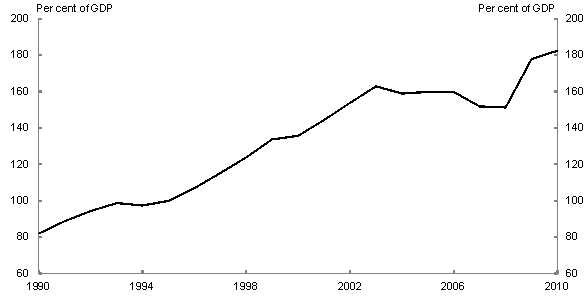China had a number of tools available for addressing the slowing effects of the global financial crisis. As these tools differ from those applied in many Western countries, it is instructive to consider the nature of these tools before discussing the specific measures adopted.
3.1 Fiscal policy
Fundamentally, fiscal policy works in the same way in China as it does in other countries: governments spend money to generate economic activity. However, China's centrally planned economy, its backlog of development and infrastructure needs, and large fiscal resources, meant that it was well placed to quickly direct large amounts of spending into the economy.
Another important feature of fiscal policy in China is that there is a particularly large vertical fiscal imbalance. That is, there is a large gap between the expenditure and revenue positions of the Central and local levels of government. The Central Government raises about 52 per cent of revenue but accounts for only around 20 per cent of expenditure. This gives the Central Government significant control over China's fiscal resources, but it must coordinate spending with multiple layers of local government, including provincial, prefecture, county, and township governments.
Complicating the transmission of fiscal policy in China is the lack of a robust system of intergovernmental transfers to the various levels of local government. Transferring money from the Central Government to the local governments that do the bulk of the spending is potentially a limiting factor when stimulus needs to be applied quickly, although in practice the Central Government was able to mobilise investment quickly by using off-budget financing vehicles.
3.2 Monetary policy
High levels of regulation of the financial sector, and a relatively inflexible exchange rate, mean that monetary policy operates differently in China compared with western countries. The banking sector is dominated by a handful of state-owned banks. Interest rates are set by the Central Government at levels that provide a comfortable margin between deposit and lending rates. Banks are constrained in how much they can lend at these pre-determined margins by Central Government policy on the quantity of lending.
Lending guidance has been a key vehicle for controlling liquidity in the Chinese economy. The PBoC usually sets an annual overall lending quota for the banking sector (although an annual quota has not been announced for 2011). The banking regulator, the China Banking Regulatory Commission (CBRC), disaggregates this quota, assigning lending quotas to each of the major banks and an aggregated quota for the smaller financial institutions. The CBRC then monitors banks to ensure they meet their lending quotas.
A further policy tool is the Reserve Requirement Ratio (RRR), defined as the amount of bank reserves over the sum of deposits and notes. The RRR reduces the amount of capital on the banks' balance sheets available for lending. In practice, it has impacted differently on the large and small banks. The larger banks have continued to hold reserves in excess of the RRR, suggesting that for them lending targets have been the binding constraint. As the smaller banks have smaller deposit bases, and often need to raise funds through the inter-bank market, they are likely to find the RRR a more binding constraint. In recognition of this, a lower RRR is currently applied to the smaller banks.
When interest rates are low and the supply of credit is constrained, small movements in rates may have little effect on the demand for credit. It appears that this has been the case in China in recent years. This is an important difference from most Western countries, which rely on movements in interest rates to regulate credit from the demand side.
As the Chinese Government manages its exchange rate, the amount of credit in the economy is also influenced by capital inflows and efforts by the central bank to sterilise these inflows. China's foreign exchange reserves rose to US$2.85 trillion at the end of 2010. The PBoC seeks to sterilise these inflows through bond issuance and changes to the RRR. Prior to the crisis, the PBoC sterilised a large proportion of foreign exchange inflows. With the onset of the crisis, the central bank reduced the sterilisation of foreign exchange inflows to ensure there was ample liquidity in the banking system.
China entered the crisis with a large amount of cash in its economy. The money supply (M2) as a percentage of GDP rose from 82 per cent in 1990 to around 150 per cent at the onset of the crisis (see Chart 3). This money supply to GDP ratio is significantly greater than in most other developing and developed countries, reflecting the under-development of China's capital markets. China's very high ratio is related to the dominance of the banks in the financial system — over half of private wealth exists as bank deposits. Also, M2 is boosted by high corporate deposits given the absence of a large bond market, difficulties for private corporations in obtaining bank credit, and the lack of alternative investment opportunities for excess corporate funds.
While the level of M2 is a function of China's stage of capital market development, the growth in M2 has been significant and has created a significant amount of new liquidity in the system. A significant portion of the resulting excess cash in the Chinese economy is held within the banks as reserves. As at December 2010, banks maintained about RMB 14 trillion of cash reserves, around one-third of GDP.
Chart 3: China's money supply (M2)

Source: CEIC Data 1990-2011.